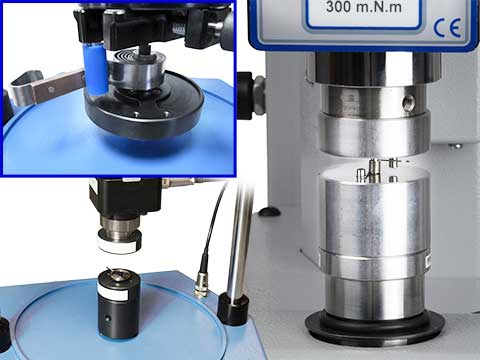The helical torsion spring comes in a wide range of geometries and varying sizes to cover almost every engineering application; from heavy-duty to fine precision. The spring’s stiffness (known as ‘spring rate’) must be measured to ensure the correct design specification for the intended use. To ensure the best possible results, a software-driven torque test system is used to rotate the spring accurately within dedicated gripping fixtures.
|
Custom-designed ‘core and drive-mandrel’ fixtures enable the spring-rate of helical springs to be accurately measured |
Spring-loaded components are used extensively in home and consumer goods: clothes pegs, clips and old-fashioned mousetraps; small doors and flaps on cameras or hi-fi equipment; large doors and closures such as those on garages or gates and in transport applications like vehicle luggage compartments.
Despite being termed ‘torsion’, and operating under torque loading, the spring itself is subjected to a bending stress when the ends rotate about its central axis, driven by the components attached to either arm (or leg).
The parts of an assembly, which are required to rotate in service, depend greatly upon the spring’s stiffness rating. This determines if the assembly is fit for purpose and exhibits the correct level of resistance for ease of operation and quality feel.

Motor-driven Vortex and Helixa systems use Emperor software to control angular rotation and measure torque values of the spring |
Unlike some compression and tension springs, torsion springs require a central supporting arbour, or core, for testing. Custom drive mandrels hold and turn the legs to load and unload the spring.
A motor-driven test stand controlled by software rotates the spring to a pre-defined angle and collects the torque and angular displacement data continuously. The software ensures repeatable testing in clockwise or anti-clockwise directions and protects against permanent set in the spring material. Approaching the target load point from below and above, then averaging, minimises the effect of friction and hysteresis on the results caused by the contact between the spring coils. The requirement to lie within specific torque range limits—when rotating the spring within its linear, elastic region—is immediately visible to operators through a clear PASS/FAIL indication.
In the smallest of torsion springs, used in precision applications, the frictional forces experienced by the coils may be highly significant. The need is greatest to employ a test system which not only ensures that the spring’s axis remains aligned to within tight tolerances, but accurately measures the resulting very light torque values.